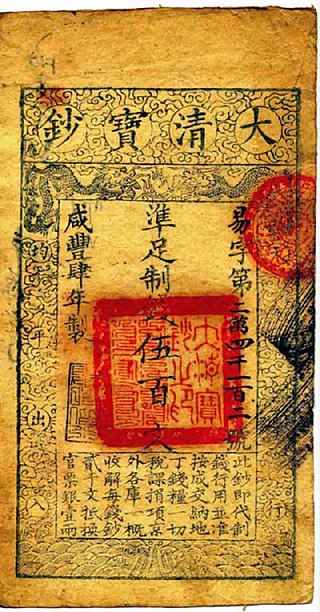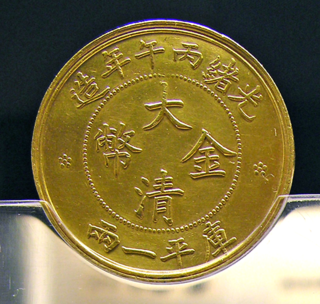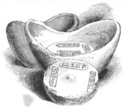
Tael, also known as the tahil and by other names, can refer to any one of several weight measures used in East Asia and Southeast Asia. It usually refers to the Chinese tael, a part of the Chinese system of weights and currency. The Chinese tael was standardized to 50 grams in 1959.

The Manchukuo yuan was the official unit of currency of the Empire of Manchuria, from June 1932 to August 1945.

The history of Chinese currency spans more than 3000 years. Currency of some type has been used in China since the Neolithic age which can be traced back to between 3000 and 4500 years ago. Cowry shells are believed to have been the earliest form of currency used in Central China, and were used during the Neolithic period.
The Yuan is the base unit of a number of former and present-day currencies in Chinese.
The history of banking in China includes the business of dealing with money and credit transactions in China.

The Imperial Bank of China was the first Chinese-owned bank modelled on Western banks and banking practices. It was founded in Shanghai by Mr. Sheng Xuanhuai in 1897 successfully operating until 1913 when it was renamed to the Commercial Bank of China. The "rebranding" was for political reasons following the overthrow of the last emperor Pu Yi by the Nationalists in 1911.

A cash seal is a type of seal used as an anti-counterfeiting measure on paper money or banknotes. The cash seal first appeared during the Song dynasty in China.
The 1 yen note (1円券) was a denomination of Japanese yen in seven different series from 1872 to 1946 for use in commerce. These circulated with the 1 yen coin until 1914, and briefly again before the notes were suspended in 1958. Notes from the Japanese government, known as "government notes," were the first to be issued through a company in Germany. Because they were being counterfeited, they were replaced by a new series which included the first portrait on a Japanese banknote. Almost concurrently, the government established a series of national banks modeled after the system in the United States. These national banks were private entities that also released their own notes which were later convertible into gold and silver. All three of these series came to an end due to massive inflation from the Satsuma Rebellion in 1877. National bank notes were re-issued as fiat currency before the national banks themselves were abolished. Both national bank and government one yen notes were gradually redeemed for Bank of Japan note starting in 1885. This redemption process lasted until all three series were abolished in 1899.

The paper money of the Qing dynasty was periodically used alongside a bimetallic coinage system of copper-alloy cash coins and silver sycees; paper money was used during different periods of Chinese history under the Qing dynasty, having acquired experiences from the prior Song, Jin, Yuan, and Ming dynasties which adopted paper money but where uncontrolled printing led to hyperinflation. During the youngest days of the Qing dynasty paper money was used but this was quickly abolished as the government sought not to repeat history for a fourth time; however, under the reign of the Xianfeng Emperor, due to several large wars and rebellions, the Qing government was forced to issue paper money again.

The Great Qing Treasure Note or Da-Qing Baochao refers to a series of Qing dynasty banknotes issued under the reign of the Xianfeng Emperor issued between the years 1853 and 1859. These banknotes were all denominated in wén and were usually introduced to the general market through the salaries of soldiers and government officials.

The Hubu Guanpiao is the name of two series of banknotes produced by the Qing dynasty, the first series was known as the Chaoguan (鈔官) and was introduced under the Shunzhi Emperor during the Qing conquest of the Ming dynasty but was quickly abandoned after this war ended, it was introduced amid residual ethnic Han resistance to the Manchu invaders. It was produced on a small scale, amounting to 120,000 strings of cash coins annually, and only lasted between 1651 and 1661. After the death of the Shunzhi Emperor in the year 1661, calls for resumption of banknote issuance weakened, although they never completely disappeared.

Qianzhuang were local independent Chinese banks in the early modern period, as distinguished from the nation-wide bank networks headquartered in Shanxi province called the "Shanxi banks". Also known by a variety of regional names, such as qiansi (錢肆), qianpu (錢鋪), yinhao (銀號), duihuan qianzhuang (兌換錢莊), qiandian (錢店), qianzhuo (錢桌), duidian (兌店), qianju (錢局), yinju (銀局), or yinpu (銀鋪) in Mandarin Chinese, and translated as money shops, native banks, private Chinese banks, or old-style banks in English, qianzhuang banks first sprung up during the Ming dynasty but greatly expanded during the Qing dynasty. Unlike the Shanxi banks, the qianzhuang tended to have much more risky business practices.

The Zhuangpiao, alternatively known as Yinqianpiao, Huipiao, Pingtie (憑帖), Duitie (兌帖), Shangtie (上帖), Hupingtie (壺瓶帖), or Qitie (期帖) in different contexts, refer to privately produced paper money made in China during the Qing dynasty and early Republic of China periods issued by small private banks known as qianzhuang. Other than banknotes qianzhuang also issued Tiexian.

Piaohao, also known as piaozhuang (票莊), huihao (匯號), or huiduizhuang (匯兌莊), in Mandarin Chinese, or Shanxi banks (山西票號) or Shansi banks in English, were a type of bank that existed in China during the Qing dynasty until approximately 1952.

The Great Qing Copper Coin, also known as the Qing Dynasty Copper Coin or Da-Qing Tongbi, officially the Tai-Ching-Ti-Kuo Copper Coin, refers to a series of copper machine-struck coins from the Qing dynasty produced from 1906 until the fall of the Qing dynasty in 1911. These coins were intended to replace the earlier cast cash coins and provincial coinages, but were welcomed to mixed receptions.

The Great Qing Gold Coin, also known as the Qing Dynasty Gold Coin or Da-Qing Jinbi, was the name of an unissued series of gold coins produced under the reign of the Guangxu Emperor of the Manchu-led Qing dynasty. These coins were produced in the scenario that the government of the Qing dynasty would adopt the gold standard, as was common in most of the world at the time.

The Da-Qing Bank was a state-controlled entity established by the Qing dynasty in 1905 to serve as Imperial China's first central bank. It issued banknotes that were intended to unify the Qing dynasty's currency system. In 1912 following the Xinhai Revolution, the Bank of China was created to take over the role of the Da-Qing Bank, which was liquidated in an orderly manner.

Daqian are large-denomination cash coins produced in the Qing dynasty starting from 1853 until 1890. Large denomination cash coins were previously used in earlier Chinese dynasties and had faced similar issues as 19th-century Daqian. The term referred to cash coins with a denomination of 4 wén or higher.
The 5 yen note (5円券) was a denomination of Japanese yen in twelve different series from 1872 to 1955 for use in commerce. Only those from the "A series", which was issued from 1946 to 1955 are legal tender today.

Qiang tie is a Chinese folk name for banknotes of the Russian ruble issued by the Russian Empire and later by the White Army. The main regions of ruble transactions in China were concentrated along the Chinese Eastern Railway and Harbin in Manchuria and Ili and Tacheng in Xinjiang. Russian currency in China began circulating in the 1860s and were withdrawn due to severe depreciation in the mid-1920s. There were many qiang tie sources, including the State Bank of the Russian Empire, the Russian Provisional Government, Omsk bonds issued by the Provisional All-Russian Government, the Russo-Chinese Bank, and the administration of the Eastern Railway.
























































